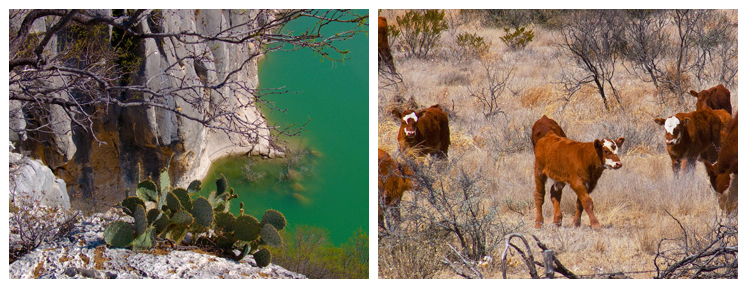
While yet another winter storm blankets the midwestern United States, a change of seasons has already begun in the far south of Texas. This time of year along the Pecos River, near where it meets up with the Rio Grande, normally includes new born calves, blooming prickly pear cactus, wild flowers, migrating butterflies, and vibrant green waters. Just what you see in the images above, made two years ago. But this year promises to be different. This year snow has been light up in the mountains near where the Pecos and Rio Grande begin. Run off from melt is barely covering the river bottom. Silt muddies what meandering waters remain and starves aquatic vegetation of sunlight. Less plant life means less oxygen in the water for fish to breath. Less clean water in the river means cattle have less to drink. Parched land also means less grass for them to eat. Summer 2011 saw the beginnings of a drought with record high temperatures, wild fires, and below normal rainfall. That same drought continued throughout 2012 with imported hay prices skyrocketing as ranchers were forced to supplement grazing for their cattle. This year will mark the third straight year of drought, a condition not seen since the dust bowl days of the 1930's. Is climate change to blame? Or is drought a normal cyclic weather pattern for the region? The answer is likely both. Climate change is exacerbating normal cycles of rain and no rain, heat and more heat. Ranchers, flora, and fauna that have endured difficult weather cycles for generations are this time finding themselves unable to cope. Extinctions are looming. Recent data and analysis overwhelmingly confirm not only that climate change is happening but that it is a direct consequence of humans burning fossil fuels. Further, the processes of climate change will accelerate as methane, an even more potent greenhouse gas, is released during the inevitable decay of thawing tundra. Scary stories you've heard so far could eventually prove something we only wish we had. A bit of good news is afoot, however. Ohio State University researchers have recently perfected a new closed loop process for burning coal that almost entirely eliminates the generation of greenhouse gases. Combined with advances in wind, solar, and geo-thermal we might actually be on the brink of being able to slow the processes by which climate is changing. Unfortunately, this year's drought is still on. And likely next year's and the year after that. I've said it before that hell is suffering the consequence of our own arrogant ignorance. Apparently, we've got a lot more suffering to endure. |
• Posted: Feb 28, 2013 09:35:53
• Comments Welcome
• Vote CoolPhotoblogs
• Purchase a Print
• Share
Tuesday, March 8th, 2011 Langtry/Sanderson TX USA |